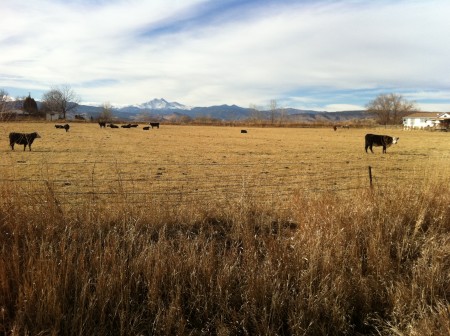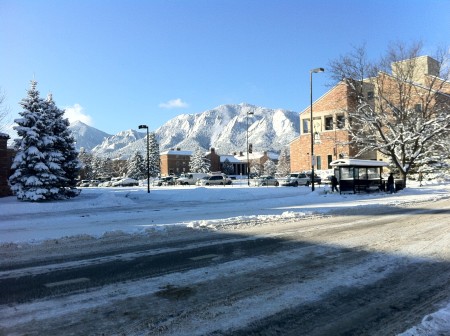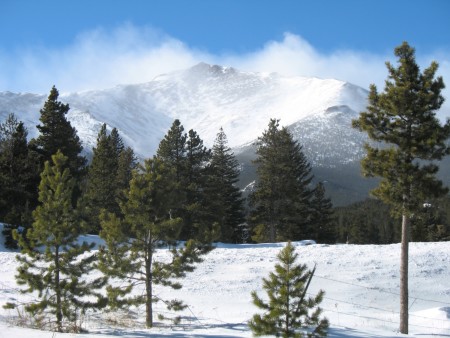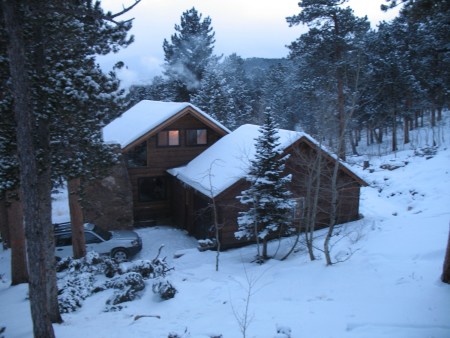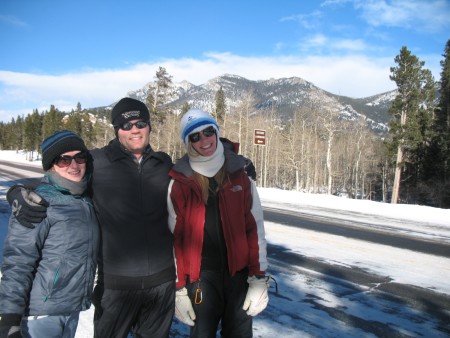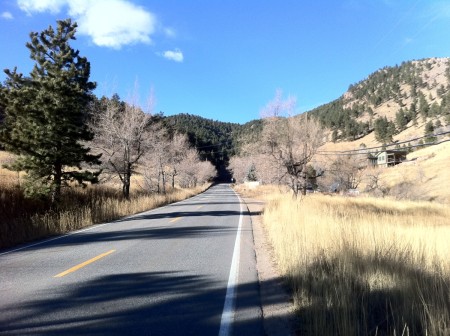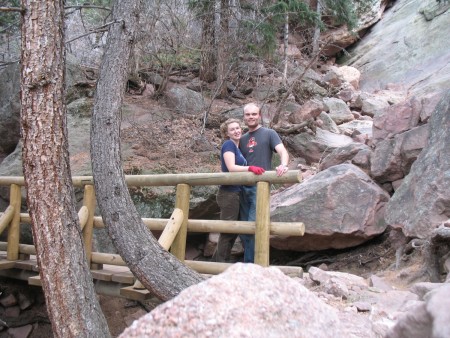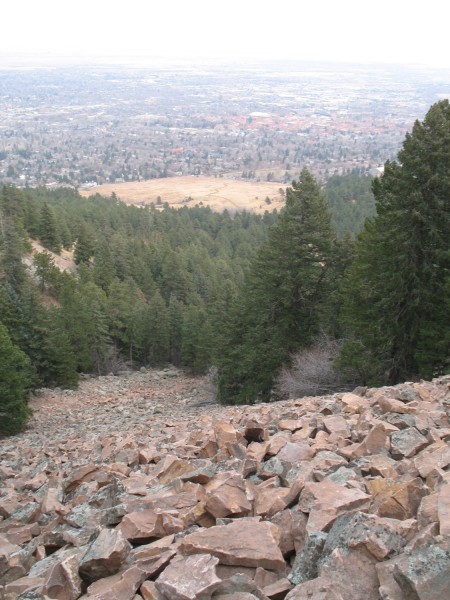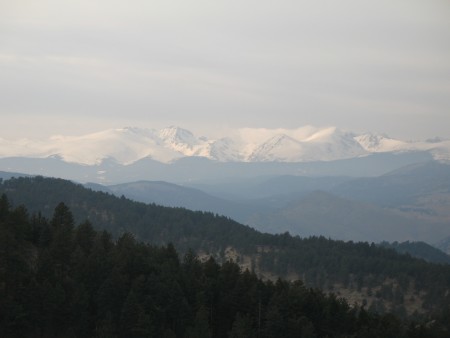Blondie – Autoamerican
The album Autoamerican by Blondie contains some good examples of popular musical styles in the beginning of the 1980's. It has disco ("Live it Up", "Do the Dark"), a rap song (!; "Rapture") that includes the often used line "hip, hop, and you don't stop", songs that sound like the B-52s ("Walk Like Me"), and a genuinely popular reggae/ska hit in "The Tide is High". It is not a boring album in the sense that there are some interesting musical choices in a (nearly) instrumental opening in "Europa" and a incongruous 30-second intro into "Angels on the Balcony".
An aside about the cover: I don't care to figure out which band member it was, but one of them was relegated to being depicted on the album cover as white pants, a black shirt, dark hair, and no facial characteristics. Sure, Blondie deserved to be up front, but if I were that last guy, I'd feel a bit insulted at being completely anonymized.
Because it isn't boring, and has the several of the contemporary musical styles represented, and the songs are generally entertaining, I think this album is a good one. So I will recommend to my readers that they check it out!
My next album review will be in two weeks because next week's top-10 chart has no albums that I have not already reviewed.
more ...Steely Dan – Gaucho
I am of two minds about Gaucho by Steely Dan. In one mind, I think the melodies are entertaining and high quality, combining Jazz, Funk, Rock and R&B. The instruments, drums, and lyrics are very tight, a result of the perfection demanded by the band. This forced the production of the album to take two years. In the other mind, I dislike the manner of the vocals. The vocalists, including a previous nemesis Michael McDonald in a backup role, do things that annoy me. Imagine Yogi Bear trying to sing, and that is what I hear in my head when I listen to this album. Unnecessary pitch bending and weird transitions from a nasal- to diaphragm-driven voice.
I am a few months into this project, and I am observing that nearly all of the music I've liked I had heard previously. I think that this is natural for a few reasons. First, I seek out music I like over music I dislike, meaning that the albums I've listened to that I disliked never entered my mind because they are in a genre I generally dislike. Of course, I couldn't have truly known I disliked them until I listened to them, but there is some personal selective effects going on. Second, and this is definitely inflating the value of my own opinions (so throw some salt over your shoulder), but it seems that music I dislike has proven itself over time to be less popular and inferior to music I do like. When was the last time you heard a Yoko Ono song on the radio? Or a Barbra Streisand song from Guilty? However, Bruce Springsteen is still making records and selling out arenas, and AC/DC is still selling records and getting airtime.
If you can get over the vocal style of this album, or indeed if you even like it, I would recommend this album for its melodies. However, that is a very qualified recommendation. Listen at your own risk.
more ...Neil Diamond – The Jazz Singer
The album The Jazz Singer by Neil Diamond is the soundtrack to the 1980 film remake of the 1927 film adaption of the 1925 broadway musical. The 1980 film has a very low rating as judged by the critics, so I'm not going to bother seeing the movie myself. Diamond's performance was so poor that this movie is Neil Diamond's only acting credit on IMDB where he's not playing himself.
There is an interesting parallel with this film+soundtrack and the 1992 flim+soundtrack The Bodyguard. The Bodyguard, like The Jazz singer, starred a successful singer (Whitney Houston) making her acting debut. The Bodyguard gets somewhat higher reviews than The Jazz Singer, but they are still far from positive. Like The Jazz Singer, the soundtrack for The Bodyguard did well - so well that it is the best-selling soundtrack ever. It appears that for a class of musicians (notably not rappers, of which many have made a successful transition), acting is not amongst their artistic skills. Neil Diamond and Whitney Houston made best-selling albums for their movies, but apparently they ran out of creative "juice" and fell flat as actors.
Despite its economic record, I find this album bland enough that it is difficult to form any kind of opinion about it. Which is probably not a good thing, unless you're in the mood for music that blends easily into the background. So, my recommendation is to skip listening to this album. Here's a look twelve years into the future: you can skip The Bodyguard soundtrack, too.
more ...John Lennon & Yoko Ono – Double Fantasy
It is easy to imagine a teen movie plot as follows: A group of guy friends are having an amazing time during summer break. Pretty girls are everywhere and always interested in them, and every night is an adventure. Life is good. But then, one of the guys starts dating a girl who all the others despise. The others can't see what is so great about her. She has destroyed the group dynamic, and offers no redeeming qualities that they can discern. The group attempts to break up the pair to no avail (with plenty of hijinks along the way), but by the end of the movie she has proven her worth in some grandiose and unlikely way.
After listening to the album Double Fantasy by John Lennon and Yoko Ono, I think this movie plot almost describes what happened to the Beatles when Yoko Ono met John Lennon. The Beatles had a really great thing going: hit album after hit album, adoring fans, and any woman they wanted. But when Yoko Ono came on the scene, things went sour, and the group became dysfunctional. The other three did not like the effect Yoko was having on John, she distracted him and pulled him away from the group. Except there was no happy ending, and the Beatles disbanded. Unlike in Hollywood, not all guys are shallow and can tell when a woman is a bad influence on one of their friends (also, in real life friends do not stay friends forever).
In short, Yoko Ono is a talentless singer with a little girl's voice who performs songs terribly. I suppose her physical artwork might be better (which is what she was doing when she met John), but that is the kind of art she should have stuck with. As far as I can tell, on this album the songs are either sung only by John or Yoko, but never together. John's songs range from merely OK to quite good and memorable. In between are Yoko's songs, which are like audible sandpaper. Maybe John was an evil genius and realized that placing his songs next to Yoko's songs would make his songs sound that much better, but I suspect this was not the case. Love can be stupid.
The reason this album is high on the charts is that just a little over 30 years ago, in early December, John was killed. Before that, the album was poorly received and wasn't getting much traction in sales or on the radio. It is unfortunate that it took his death for the album to reach #1, but that is what happened. It is testament to his popularity that the album sold so well, despite Yoko's presence on the album.
Below are the notes I took listening to this album, verbatim. I can't make it any more pleasant and polite than this:
1 - good, you've heard it before.
2 - awful. terrible. pornoaudioic.
3 - bleh
4 - Terrible. Yoko again. Wow.
5 - John again, so not terrible.
6 - voice reverb/echo on Yoko, double terrible. "oving on" sounds like "looking on" with the "L" dropped. Speech impediment, or ESL?
7 - dreamy and OK, but not stellar.
8 - good, quality, you've heard it before.
9 - more ono, more suckage.
10 - OK, John.
11 - pointless, useless voice trembles, awful falsetto (Yoko, of course)
12 - about/to Yoko, but it's by John, so it's OK
13 - best Yoko because she is hidden behind the music.
14 - Ugh. Yoko.
It is always easier to write a negative review, and who-boy, this week was easy! I think I never quite understood just how awful Yoko was until I listened to this album, and now I think I have a better understanding of why everyone blames Yoko for the end of the Beatles. They did have some right to be angry, and that is one of the emotions I felt listening to this album. If you want to listen to this album, skip any and all songs by Yoko, and listen only to John's, some of which are worthwhile.
It's hard to over-emphasize how bad Yoko was. Check out this video made of Bill Burr talking about a time that John and Yoko played with Chuck Berry. The language is R-rated, but the point he makes is valid.
more ...
What Earning a PhD Does to Physical Activity
Above is a plot showing how many hours I have logged on my Garmin GPS devices since I got my first one in April 2005. This is mostly cycling, but also walking, running and some hiking. However, this is not a true measure of my physical activity over this period because it is missing data. Up to late 2007, I was active on the velodrome, and I didn't bother using my GPS there. In the last year, I've tried to walk to school more often, and for the most part I haven't used my Garmin on those walks. But it does capture the majority of my physical activity, which is road and mountain biking, where I always use a GPS.
In green I've over-plotted a linear fit to the data. I have chosen a linear fit as it shows the overall trend in the clearest way possible. For some reason, June 2006 shows zero hours, which I believe to be wrong. I can't believe I did nothing at all during any summer month in 2006. Therefore, for purposes of the fit, I have given that month the average hours of the four bracketing months.
Even knowing that lots of data is missing from both the front- and back-ends of the figure, it is still clear what the overall trend was. Down - down significantly from nearly 30 hours a month five years ago to just above 10. There of course is a great variability from month to month, but the fit shows clearly the overall trend of what trying to finish graduate school does to physical activity.
I find the lack of patterns interesting. Some years, I really struggled to stay active during the late fall, which makes a certain amount of sense when weather and schoolwork is factored in. However, other years it apparently didn't affect me at all. The bounce in hours since October 2010 makes sense because that's when I graduated, but the two months in 2010 with 25+ hours is confusing. I can't remember how I achieved that!
Nerd time: I made the figure in Python using matplotlib and numpy. Excel is for suckers!
more ...The Police - Zenyatta Mondatta
It's hard to form a fresh opinion (but I'll try!) about the album Zenyatta Mondatta by The Police because I've heard this album many times before without fully realizing it. I've owned The Police complete box set since high school, and as it turns out, the order of the last eleven songs on disc 2 is identical to the tracks on Zenyatta Mondatta. This means that to a large extent I formed my opinions about this album a long time ago.
The Police have roots in punk rock, which is evident from their early work (see disc 1 of the box set), but by this album, their style definitely shifted away from that. This album has a few kinds of songs: the political "Bombs Away", "De Do Do Do, De Da Da Da"; the cute "Man In A Suitcase"; the creepy/literary "Don't Stand So Close To Me"; and the rare instrumentals "Behind My Camel", "The Other Way of Stopping". It is certainly a more mature style, that overall I prefer over the intellectually lighter punk songs.
In fact, this album kind of hits the sweet spot for me between their early punk and their later, extremely political work. This is due to the lead singer of The Police, Sting, who is very active in these sorts of things around the world. However, just like Christian music, too-political music stinks because it's preachy and bland.
I would recommend this album, and the whole box set, too.
more ...New Years 2011
To celebrate New Years we stayed for a few days at a cabin belonging to the family of our friend Chris in Allenspark. Chris, his ladyfriend Emily, and our friends Matt, Erin, and Steve all got together for winter sports and good times. The cabin is in a very pretty place, in the shadow of Mt. Meeker (pictured above), at about 8,600 feet above sea level.
Two days before the new year a storm front arrived dropping less than a foot of snow, but bringing behind it very cold temperatures and high winds. The coldest day (New Years Eve) never rose above 10 degrees Fahrenheit, and with wind chill it felt colder than 20 below. Our friends bravely skied, and we (Melissa and I) tried to snowshoe, but we gave up after a few minutes because it was so miserable. New years day was a bit warmer, and a few of us went snowshoeing near the cabin.
Overall, it was a very fun weekend and we were glad to see our friends. And, happy new year to you!
more ...Eagles – Eagles Live
I do not attend many live music performances. But I'm knowledgeable enough to know that there are some bands that are worth seeing in person because they bring something special to a live performance. For a jam band like the Grateful Dead, where no two performances are identical (or even reproducible), a true fan knows that a studio record is missing the full Deadhead experience. This is why the bootleg market for Grateful Dead concert tapes is (was) so big for so long. Some other bands may not make each performance as varied, but fans still want to see the band in person because it's more personal and memorable. For bands like this, releasing a live album per show, something that Pearl Jam has done in the past, allows a fan to buy a recording of the show they attended as an audio keepsake.
In light of the above, I don't quite understand the appeal of live albums like Eagles Live. The songs are as identical to the studio versions as I've ever heard from a live album. The crowd noise is minimal, as are the musings by the band to the crowd between songs. The one embellishment I can catch is "Winslow, Arizona" is switched to "Southern California" in Take It Easy (the concert took place in Long Beach, which I only learned through the Wikipedia page). The personal and unique touches of a live performance are almost absent from this recording. I don't see the point of a live album if it doesn't offer something that a studio album doesn't.
What is it with acrimony within rock bands? Apparently, the members of Eagles were so angry with each other that the final touches of this album were done with the help of at least five lawyers. At least the cover of this album, without the band on it, avoided the mistake The Doobie Brothers made.
Bottom line: Skippable. Get an Eagles studio album instead. And then go watch The Big Lebowski.
more ...Chautauqua Hike
Today Melissa and I hiked in Chautauqua in Boulder up to two of the Flatirons. We didn't exactly plan to do it; we decided on our way up to simply take the steepest choice whenever trails intersected. According to the GPS (which had difficulty with accuracy due to the trees and the terrain) we climbed over total 1700 feet to above 7000 feet.
Part of the way up the trail was a large rock fall, pictured above. There is no doubt that it is left over from the process that created the Flatirons. The trail crossed the rock fall twice, and each time I found it very remarkable just how fluid-like it looked. Smaller rocks were piled up behind larger rocks, like water in a stream. The view down to Boulder was good, of course, but it was a bit hazy today.
From behind the Flatiron at the top we could see farther west into the Rockies, where the peaks are covered in snow. I'm not strong on the local peaks yet, but this photo was taken looking perhaps a bit North of West, if you'd like to take a stab at it.
We won't be having a white Christmas in Boulder, but I think being able to go for a hike like this on the Eve is a fair trade.
more ...Pat Benatar – Crimes of Passion
This is the second album I've listened to with a female lead singer, and Crimes of Passion by Pat Benatar is by far a better album than the first. Of the two, this album is much more entertaining, lively, and worthwhile.
The album includes the hit "Hit Me with Your Best Shot", a confident song about female empowerment that is much more convincing than any of Babs stuff. "Treat Me Right" is similarly strong. "Hell Is for Children", about child abuse, became a bit of a radio hit and may have helped lead to the 1980's theme of musical telethons such as "We Are the World" in 1985.
My recommendation is that this album is worth checking out. If you listened to the Streisand album, I think this is especially good advice.
more ...Boulder Weather
I don't often post twice in one day, but I had to show this:
Sunset was at 4:36pm (and the sun fell behind the mountains even before that), but as you can see above, it actually got warmer as the sun set. The wind also picked up at the same time, and the air pressure fell, indicating that the heat was due to the wind warming up as it blew down the mountains. Boulder weather is weird!
more ...The Doobie Brothers – One Step Closer
In the movie The 40 Year Old Virgin the main character works in an electronics store, similar to Circuit City or Best Buy. Along one side of the store is the ubiquitous wall of TVs, all playing the same video for purposes of comparison between different sets. The store manager has decreed that the same video (and accompanying audio) will be played on repeat, all day long, every day, for the last two years. The video is of a performance by Michael McDonald of his song Yah Mo B There, which drives many of the employees crazy.
Michael McDonald was the lead singer for The Doobie Brothers for the album One Step Closer. Listening to this album a few times this week has felt a little like being an employee of the fictional store. It's the kind of smooth rock that has very little substance and gets played in elevators or dentists offices. Only seriously messed up people like this kind of music, which describes the store manager exactly. But it doesn't describe me (I hope!).
The album has exactly one thing going for it: a rare xylophone solo on "Thank You Love." I haven't heard a xylophone solo since music class in grade school.
If you follow the Wikipedia link to the page about the band (above), you'll find out that the band was in a very fractious mood during the making of this album. Many of the band felt overshadowed by McDonald and disliked his musical influence on the band. The tension in the band is obvious in the cover photo. Slumped shoulders, blank expressions, crossed arms, one member is almost entirely hidden, and McDonald is off to the side (in the white shirt) leaning away from the others. This is the kind of picture one gets from sullen teenagers, not adult musicians wanting to sell millions of copies of their record.
more ...